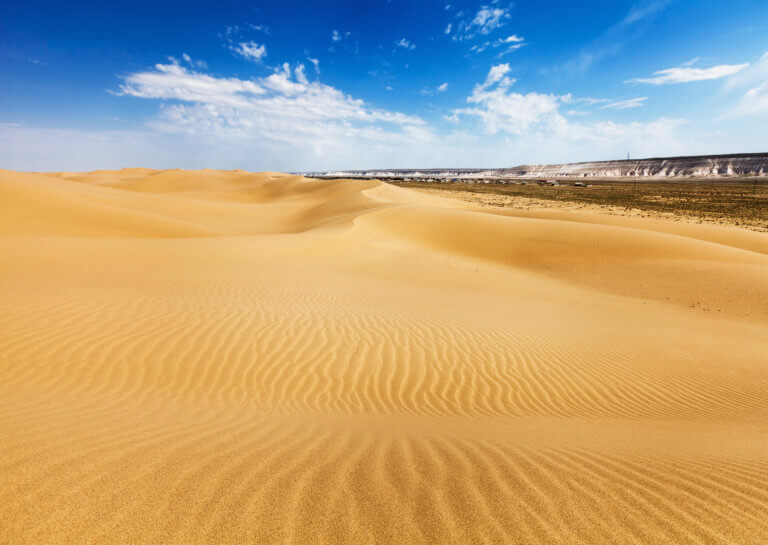
Senek Sands
Senek Sands, also known as Tuyesu Sands, is an 11 x 30km area of dunes located halfway between Zhanaozen city and Boszhira. Barchan dunes cover
The main sections of the Karakavak and Shuldor Canyons start east of a dirt road junction. Both run north for roughly 9km before opening up in front of a small and shallow cove in Kochak Bay, which can freeze in winter. Their total drop in elevation is over 150m and the cliff height is similar in size in certain spots.
In 2017, a Russian-Kazakh archaeology expedition conducted a survey of Kochak Bay, around the Karakavak area, searching for the remains of 16th–18th century piers. According to accounts by Bekovich-Cherkassky, the piers served as the primary landing point and trade hub for vessels coming from Astrakhan in the 16th–17th centuries.
Backing up Bekovich-Cherkassky’s account are the memoirs of the 19th-century Russian naval officer M.I. Ivanin who reported seeing old wooden piles in Kochak Bay. Russian navy maps from 1848 and 1869 mark their location in a small nook within the bay and refer to them as ‘Karagan’ and ‘Old Mangyshlak’.
The 2017 expedition didn’t find any remains of the piers. However, it’s not unsurprising—the organiser of the research project, Andrei Astafiev, said that the sea has receded by several hundred metres over the last three centuries, leaving any remains exposed to the harsh climate or prone to being buried by wind-blown sand.
Shuldor Canyon, less than a kilometre to the east, runs parallel to Karakavak and there’s a dirt road along the dividing plateau. Shuldor is considered the more picturesque of the two. Both are part of the Aktau-Buzachinsky Nature Reserve. Karakavak also has 8th–9th century remains of a citadel, when it once served as a stopover point for caravans arriving from Khwarezm. Spanning east to west between the two canyons is a half-kilometre-long defensive wall of the same era, too.
Karakavak Canyon (Qaraqauaq Kanony/Каньоны Каракавак) dirt road junction start point: 44.4307, 51.3856
Shuldor Canyon (Şuldor Kanony/Каньоны Шульдор): 44.4731, 51.4294
Defensive Wall: 44.4598, 51.4225
Estimated Location of Old Piers: 44.5335, 51.3620
An Aktau-based off-roader’s photos of Karakavak and Shuldor Canyons, taken in 2018, and another set in 2019.
1:200k Soviet map of Kochak Bay, pictured in the top-centre, with Sarytash Bay to the west.

Senek Sands, also known as Tuyesu Sands, is an 11 x 30km area of dunes located halfway between Zhanaozen city and Boszhira. Barchan dunes cover

Boszhira is Central Asia’s rival to the USA’s Monument Valley National Park, with the bonus of no crowds. Packed into a 7km x 7km area

Tucked away inland of Sarytash Bay is the 10th-century Shakpak Ata, one of Mangystau’s most well-known historical-religious sites. Tauchik, a small village, is the nearest
Copyright © Planet Esoterica, 2024. No part of this site, www.planetesoterica.com, may be reproduced in whole or in part in any manner without the permission of the copyright owner. All rights reserved.
Made with 